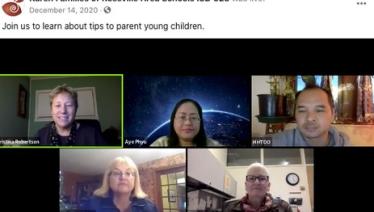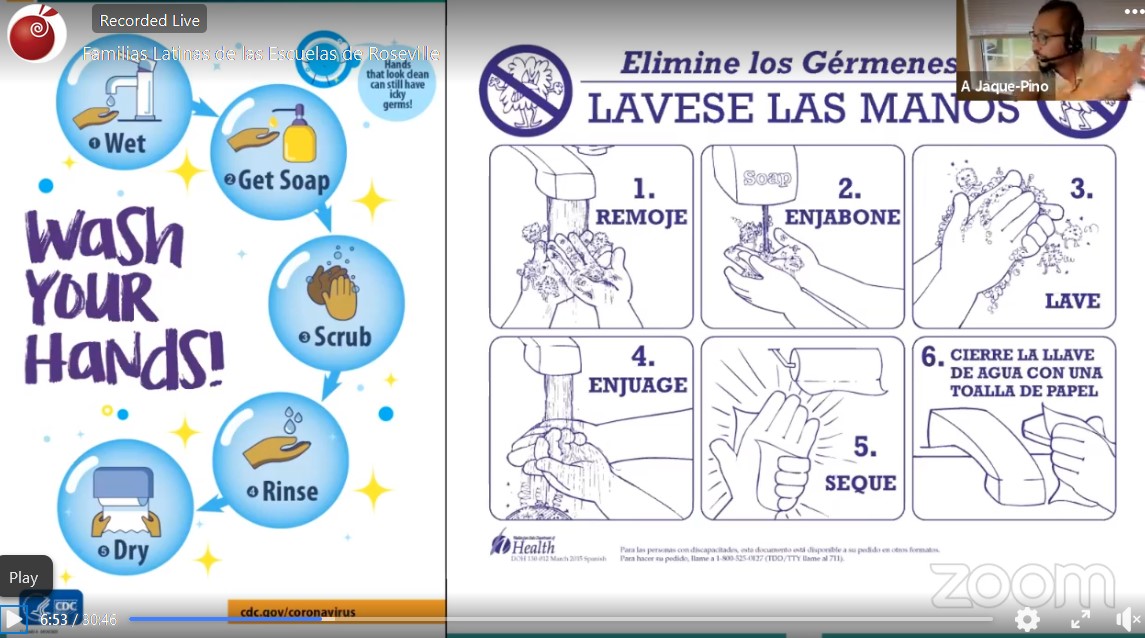As schools look for different ways to build successful partnerships with multilingual families, good communication is crucial. There are more options than ever before for educators and administrators to connect with families of English language learners (ELLs) and keep that communication strong. Here are some tips for schools and resources to explore.
Note: This article was originally written during the COVID-19 pandemic and has since been updated with more general information.
Language access resources
1. Share information about families' rights to information in their language.
School districts are legally required to provide information in families' home languages. You may need to share information about these rights with families themselves, colleagues, or administrators if families are not getting the information they need in their language.
You can learn more about best practices for increasing families' language access from the following:
- Communication with Multilingual Families
- Equity Through Language Access: Best Practices for Collaborating with Interpreters
- How to Expand Language Access: Interview with Dr. Jennifer Love
- How to Fulfill Translation and Interpretation Requirements: Tools for Guiding Decisions (Immigrant Connections)
2. Identify your language access options.
If you are don't know what your language access options are, contact ELL educators or administrators from your school or district to find out more. Interpretation/translation resources may include the following:
School / district interpreters
Your school or district may have trained interpreters, as well as bilingual staff. It is important to note that bilingual staff and interpreters play different roles:
- Bilingual/multilingual staff speak multiple languages. They may also be able to write and translate in those languages, but that is not always the case. They may not have had formal training in translation or interpretation.
- Interpreters have received extensive training related to best practices for interpreting/translation, as well as training on specific legal and educational considerations and technical language around matters where they will be interpreting.
If your school or district has interpreters, find out:
- if and when they are able to assist with family communication
- what process they prefer for setting up conversations
- what has worked (or not) in the past
- if there are other translation resources that you should be familiar with
- if families have common questions that can be addressed more efficiently
- if there are some ways to make technical support in families' home languages more efficient
- if there is anything you can do to support their work.
District translation hotline
Your school district may offer a translation hotline. Find out if it is currently available and, if so, how you can use it to set up conversations with families. If the hotline's hours don't match your families' availability, talk with an administrator about whether other options may be available.
Translation apps
Ideally, districts will have in-person interpreters available as part of their legally mandated obligations to make information available in families' home languages. However, there are tools that can help fill in some of the gaps.
Talking Points is an app that translates messages between teachers and families in many different languages. Here's how it works:
- Parents receive the messages as a text message and do not need to download an app.
- It's free for individuals and can be purchased for broader use by districts.
- Translations are done automatically but human interpreters are available if needed.
- You can send mass texts as well and teachers' numbers are protected.
Illinois multilingual education administrator Sarah Said notes, "It's an application that works as a text message on parents' phones. It enables two-way translation communication with families. You can send mass texts for free! It has been a LIFELINE."
The Talking Points can help give individual teachers more options in reaching out to families directly rather than relying on an intermediary. Please note, however, that it should not be considered a wholesale substitute for professional, knowledgeable interpreters and liaisons who are familiar with:
- the language and culture of the families
- technical school terms, especially for special education
- strategies that can help build trust and community among ELLs and their families.
AI tools and online platforms
Many AI tools and online platforms, including Learning Management Systems, offer translation. Find out if your district offers any approved tools and what the policies are for their use. While these services can open up many opportunities, keep in mind that automated translation is not foolproof.
When to use what method of contact
Some information may be more suitable for texts (shorter messages, reminders, and check-ins) than lengthy or sensitive information, or information that is legally required to be translated. Please take a look at these privacy and security considerations for ELLs and immigrant families if you are considering using Talking Points or other apps.
Keeping contact information updated
It's essential that schools have accurate contact information for families. Understanding why families' contact information might change, how they prefer to update that information, and how the school can make it easier for them to do so can go a long way in helping everyone stay connected.
Partnering with ELL Families
Learn more from the following:
3. Find families' contact information.
Start by gathering contact information or confirming existing information. This may be challenging if families' housing and economic situations are unstable. Families who use prepaid cell phones may also change phone numbers regularly.
If you don't have updated contact information for families, consider trying to pass on a message through:
- other students or families (including through families' networks among themselves)
- an interpreter, family liaison, or ELL educator who knows the family
- other educators such as teachers, coaches, and counselors
- teachers of other children in the family
- community or faith-based organizations serving your students' families.
4. Help families keep their contact information updated.
Ensure that families understand why the school needs updated contact information. You may wish to provide translated emergency contact forms or other tools that can help.
Learn how to make this easier for families in The Importance of Keeping Emergency Contact Information Updated (and keep in mind that families' with limited internet access may not be able to log in easily to parent portals).
5. Ensure that families know how to contact you or the school.
Make sure that families have:
- updated contact information for their child's teacher
- updated contact information for any other adult who will be working with their child, such as an ESL specialist or special educator
- information on contacting an interpreter or getting necessary information in their home language
- information on getting technical support in their home language.
You may also wish to provide a translated information form to help families keep this information organized. In addition, ensure that families know that they are allowed (and encouraged!) to reach out to their child's school with questions.
Preferred methods of communication
6. Find out how families prefer to communicate.
Each family will have their own preferences on how to communicate, although there may be some similarities among families from particular communities who are using the same methods. The more you know about how families wish to communicate, the more successful your communication will be. You can learn more about tech tools that can support this communication in How to Use Technology to Engage Multilingual Families.
Phone calls
You may wish to start with a call if you have families' phone numbers. This will also allow you to reach some families who don't have internet access. Keep in mind that some families are not allowed to answer their phones while working.
Texts
Some families may prefer to communicate by text. That will allow them to respond at their convenience. You may also wish to text video messages to your students or families with information, greetings, or messages of encouragement. Many immigrant families use WhatsApp and create large texting groups as part of the app.
Social media
Many schools have had success in communicating with ELL families through social media, including Facebook messenger or a dedicated Facebook group with translated information. For example, the Roseville, MN school districts posts bilingual information for families on its community Facebook pages, including translated messages from a family liaison. For more ideas on how to engage effectively with multilingual families in virtual settings, see these ideas from Dr. Karen Woodson.
Email & online communication
Many ELL educators have reported that emails and newsletters are not a good option for their families. Sending out updates doesn't guarantee that families have received them or gotten the important information they need from them. If you don't receive responses to your emails, consider calling or texting instead. Just because families have provided an email address doesn't mean they are using it or are comfortable sending emails to a teacher. Other online options include doing a video chat, sharing a survey or family check-in form (perhaps via Google Forms), or sharing some online learning resources.
Notes:
- Assisting families with access to devices and internet may also improve communication, although as this related article from the COVID-19 pandemic notes, the technology alone won't do the trick without strong relationships and tech training and support.
- Your district may have policies in place regarding student privacy and online learning, such as restrictions on videos or images of students. Check with your school administrator for clarification as needed to protect student and family privacy, as well as with your families to find out if they have any concerns.
Mail and more
During the pandemic, some teachers connected with families through creative ways such as post cards or attaching contact information to food delivery. One teacher who sent her phone number via pizza delivery heard back from the family she was trying to contact!
7. Find out when families prefer to communicate.
Keep in mind that immigrant families may be juggling a number of challenges and responsibilities that impact how and when they can communicate with the school. Some families may:
- work outside of the home during the school day, during the evening, or overnight
- need to juggle child care and other family caregiving responsibilities during the day
- work for employers that have strict rules about responding to phone calls or texts during their shift
- follow cultural norms regarding family or gender roles around communication.
The better you know your families, the more you can learn about their schedules and their family's situation.
Supporting learning
8. Identify the information and updates that ELL families will need in their language.
Does planning and communication in your district take ELLs and their families into account? ELL families will need to know:
- the school schedule
- information about school closures (whether planned or due to weather, etc.)
- how to communicate with their child's teacher
- how to access lessons, assignments, and updates about their child's progress
- access to devices, internet, and technology training and support
- information about ELL or special education services and support.
Families may not be aware of the services the school provides around school meals, health care, social-emotional support, how to support learning at home, or parenting tips for managing schedules and routines. Sharing this information broadly and then getting to know individual families is the best to address their priority questions!
Building relationships
9. Look for ways to build relationships with ELL families.
ELL families are valuable partners, yet they are often overlooked in family engagement. The school-family partnership is a two-way street — just as schools have important information they want to convey to families, families have important information about their children and questions they want ask of schools. This partnership is not born overnight, and it may take time to build trust. However, by working steadily on aspects listed above, schools can increases their chances for success, especially when they make it a priority to make families feel welcome and build school-family partnerships.
As you communicate and connect with families, keep the following tips in mind:
- In the words of one of our advisors, take time to ask how families are doing, not what they are doing. Like many families, they may be facing complex challenges. Educators or liaisons who know your ELL families well may also have valuable insights. Ask them what their questions are.
- Learn more about the families' strengths and interests. Start with low-key topics and avoid asking direct personal questions that may make them nervous. Over time, you may learn more about their prior experiences.
- Share something about yourself that helps them relate to you as a person, such as a photo of you with a pet or doing a hobby.
- Ask them to tell you more about their children's strengths, talents, and personality. As you get to know the child, share successes and observations that indicate that you are seeing the whole child.
Keep in mind the following:
- Many families may have different perspectives on the role of the family in schooling based on the experiences within their culture. The idea of a "school-family partnership" — not to mention the shift to schooling children at home — may be very new to immigrant families and they may not respond to the school's outreach efforts in the way that other families do. You can learn more about how to engage families and encourage their leadership from our ELL family engagement guide.
- Some families and students may be more comfortable in settings that are more oriented to the group as opposed to the individual. For example, some families may prefer group family conferences where they can learn from each other's questions and then break off for smaller individual conversations as needed.
10. Ask families what has worked (or not) so far.
Your families may have helpful insights about their past experiences with their children's schools. Topics related to communication might include:
- getting updates from the school
- being in touch with their child's teachers
- how they prefer to communicate
- questions about technology access and tech support
- whether they have had enough information to support their child's learning.
How administrators can help
Making space in teachers' schedules for the time and effort needed for the above strategies (especially if they do not yet have a relationship with the family) may seem difficult given all that they are juggling. In the long run, however, it will:
- fortify those critical connections
- allow them to plan more effective and efficient instruction around students' situations.
Administrators can help in this effort by:
- acknowledging the importance of this communication
- ensuring teachers have the necessary time to communicate effectively with ELL families in their schedules
- ensuring that current policies and resources support teachers' ability to succeed in ELL family communication.
Administrators may wish to reach out to staff members, including ELL and bilingual educators, interpreters, family liaisons, and paraprofessionals, to talk about:
- schedules
- case load
- availability
- their ideas on how to make communication more efficient.
Closing thoughts
Most importantly, don't give up! While it will be a challenge, as this teacher notes, families you connect with will likely be appreciative to hear from the school:
I spent a chunk of my day today calling families using Google Voice. I didn't get through to most, but the ones I did talk to were SO grateful for the clarification about what's going on. I even got to hear a few of my sweet kiddos' voices. — Megan Kingery
Your ELLs and their families will be powerful partners on this journey — once they are invited to the table!
Acknowledgements
Note: Special thanks to Larry Ferlazzo and the educators who contributed to his Education Week series on distance learning and responding to the school closures early in the COVID-19 pandemic.



 To see what this outreach looks like, take a look at the pages below. On the Spanish page (Familias Latinas), you will see numerous presentations from middle school ELL teacher Alonso Jaque-Pino on topics ranging from hand-washing to hybrid schedules. Alonso is just one of the many staff members working actively to share information on these pages.
To see what this outreach looks like, take a look at the pages below. On the Spanish page (Familias Latinas), you will see numerous presentations from middle school ELL teacher Alonso Jaque-Pino on topics ranging from hand-washing to hybrid schedules. Alonso is just one of the many staff members working actively to share information on these pages. In addition, the district has used Zoom more for school-based town hall meetings. Kristina notes that it can be challenging for families to navigate Zoom. It takes a lot of staff time on the ground to provide direct support for families who want to attend. The other issue is getting Zoom info and log-in information to families. Most people register for events through email and receive a link. That won’t work for many of the district's multilingual families who aren't regularly using e-mail, so the district needs to rely on staff to connect with those who express an interest in attending.
In addition, the district has used Zoom more for school-based town hall meetings. Kristina notes that it can be challenging for families to navigate Zoom. It takes a lot of staff time on the ground to provide direct support for families who want to attend. The other issue is getting Zoom info and log-in information to families. Most people register for events through email and receive a link. That won’t work for many of the district's multilingual families who aren't regularly using e-mail, so the district needs to rely on staff to connect with those who express an interest in attending.